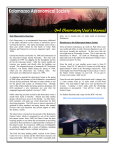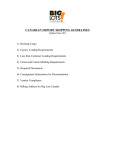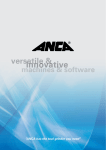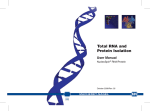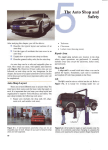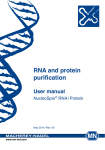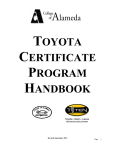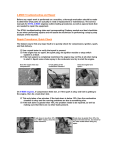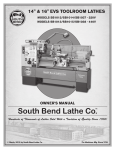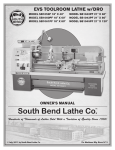Download Safety power point CHAPTER 05
Transcript
by Russell Krick Publisher The Goodheart-Willcox Co., Inc. Tinley Park, Illinois © Goodheart-Willcox Co., Inc. © Goodheart-Willcox Co., Inc. Auto shop layout Shop safety Types of accidents General safety rules © Goodheart-Willcox Co., Inc. Safety If basic safety rules are followed, an auto shop can be a safe and enjoyable place to work © Goodheart-Willcox Co., Inc. There are several different areas in an auto shop These areas include: repair area toolroom classroom locker room © Goodheart-Willcox Co., Inc. Repair Area Includes any location in the shop where repair operations are performed Normally includes every area except the classroom, locker room, and toolroom © Goodheart-Willcox Co., Inc. Shop Stall Small work area where a car can be parked for repairs Sometimes, each stall is numbered and marked off with lines painted on the floor © Goodheart-Willcox Co., Inc. Lift Used to raise a vehicle–useful when working under the car © Goodheart-Willcox Co., Inc. Lift Safety Rules Ask your instructor for a demonstration and get permission before using the lift Center the vehicle on the lift, using the lifting points described in the service manual Check ceiling clearance before raising trucks and campers © Goodheart-Willcox Co., Inc. Lifting Points Recommended lifting points for a specific vehicle © Goodheart-Willcox Co., Inc. Safety Catch Make sure the lift’s safety catch is engaged before working under the vehicle © Goodheart-Willcox Co., Inc. This is the safety catch on our lifts. Can can not see the latch that locks into these blocks. © Goodheart-Willcox Co., Inc. Alignment Rack Specialized stall used when working on steering and suspension systems © Goodheart-Willcox Co., Inc. Alignment Rack When using a rack, the car should be pulled on the rack slowly and carefully Someone should guide the driver and help keep the tires centered on the rack Obtain a full demonstration before using the alignment rack © Goodheart-Willcox Co., Inc. Outside Work Area Some shops have an outside work area In good weather, this area can be used for auto repairs Always raise the shop doors all the way and pull cars through the doors very slowly Check the height of trucks and campers to make sure they will clear © Goodheart-Willcox Co., Inc. Toolroom Shop area normally adjacent to the main shop or classroom Used to store shop tools, small equipment, and supplies When working in the toolroom, you must keep track of shop tools Every tool checked out must be recorded and called in before the end of the class period © Goodheart-Willcox Co., Inc. Toolroom Keep all shop tools clean and organized © Goodheart-Willcox Co., Inc. Classroom Used for seminars, demonstrations, and other technician training activities May also be used for employee meetings © Goodheart-Willcox Co., Inc. Locker Room Usually located adjacent to the main shop Provides an area for changing into your work clothes Always do your part to keep the locker room clean and orderly © Goodheart-Willcox Co., Inc. Every year, thousands of technicians are accidentally injured or killed on the job Most of these accidents resulted from a broken safety rule While working, constantly think of safety © Goodheart-Willcox Co., Inc. Potential Dangers Just a few of the dangers present around an automobile © Goodheart-Willcox Co., Inc. Be aware of and try to prevent six kinds of accidents: fires explosions asphyxiation chemical burns electric shock physical injuries © Goodheart-Willcox Co., Inc. Plan Your Actions If an accident or injury occurs in the shop, notify your instructor immediately Use common sense when deciding whether to get a fire extinguisher or to take other actions © Goodheart-Willcox Co., Inc. Fires Terrible accidents capable of causing severe injury and permanent scar tissue Every precaution must be taken to prevent fires There are numerous combustible substances found in the shop: gasoline oily rags paints and thinners © Goodheart-Willcox Co., Inc. Gasoline Safety Rules Store gasoline and other flammables in approved, sealed containers When disconnecting a fuel line or hose, wrap a shop rag around the fitting Disconnect the battery before working on a fuel system © Goodheart-Willcox Co., Inc. Gasoline Safety Rules Wipe up gasoline spills immediately Keep any source of heat away from fuel system parts Never use gasoline as a cleaning solvent © Goodheart-Willcox Co., Inc. Storage of Combustibles Soiled rags should be stored in an approved safety can Paints, thinners, and other combustibles should be stored in a fire cabinet Never set flammables near a source of sparks, flames, or heat Note the location of all fire extinguishers in your shop © Goodheart-Willcox Co., Inc. Electrical Fires Result when a current carrying wire touches ground Wire can heat up, melt the insulation, and burn Other wires can then do the same To prevent electrical fires, always disconnect the battery when instructed to do so in a service manual © Goodheart-Willcox Co., Inc. Explosions Rapid, almost instant, combustion of a material that causes a powerful shock wave to travel through the shop There are several potential causes of explosion in the shop: hydrogen gas emitted by batteries fuel tanks or containers sodium-filled engine valves welding tanks and propane bottles © Goodheart-Willcox Co., Inc. Asphyxiation Caused by breathing toxic or poisonous substances Causes dizziness, headaches, vomiting, and even death Automobile exhaust gases cause most cases of asphyxiation in automotive shops © Goodheart-Willcox Co., Inc. Asphyxiation Place an exhaust hose over the tailpipe of any car running in an enclosed shop © Goodheart-Willcox Co., Inc. Harmful Substances Other shop substances are harmful if inhaled These substances include: asbestos dust from brake or clutch linings parts cleaners paint spray © Goodheart-Willcox Co., Inc. Harmful Substances This technician is wearing a respirator for protection from toxic welding fumes © Goodheart-Willcox Co., Inc. Chemical Burns Solvents, battery acid, and various other shop substances can cause chemical burns Always read the directions on all chemical containers Wear proper protective gear when handling solvents and other caustic materials © Goodheart-Willcox Co., Inc. Chemical Burns Protective gear for preventing chemical burns © Goodheart-Willcox Co., Inc. Carburetor Cleaner Very powerful decarbonizing product that can severely burn your skin in a matter of seconds Wear rubber gloves when using carburetor cleaner © Goodheart-Willcox Co., Inc. Electric Shock Result of electric current passing through parts of your body, causing injury or death Can occur when using improperly grounded electric power tools Never use an electric tool unless it has a third round prong on the plug socket Never use an electric tool on a wet shop floor © Goodheart-Willcox Co., Inc. Physical Injuries Can result from hundreds of different accidents You must evaluate every repair technique Decide whether a particular operation is safe and take action as required e.g. if you are pulling on a wrench as hard as you can and the bolt will not turn, stop, and find another wrench that is larger © Goodheart-Willcox Co., Inc. There are several general safety rules that should be followed at all times © Goodheart-Willcox Co., Inc. Safety Rules Wear eye protection during any operation that could endanger your eyes Avoid anyone who does not take shop work seriously Keep your shop organized Dress in an appropriate manner © Goodheart-Willcox Co., Inc. Safety Rules Never carry sharp tools or parts in your pockets Wear full face protection when grinding, welding, or performing other hazardous operations Work like a professional Use the right tool for the job © Goodheart-Willcox Co., Inc. Safety Rules Keep guards or shields in place Lift with your legs, not your back Use adequate lighting Ventilate when needed Never stir up asbestos dust asbestos is a carcinogen do not blow dust from brake or clutch parts © Goodheart-Willcox Co., Inc. Safety Rules Jack up a vehicle slowly and safely © Goodheart-Willcox Co., Inc. Safety Rules Never work on a vehicle not supported by jack stands © Goodheart-Willcox Co., Inc. Safety Rules Drive slowly when in the shop area Report unsafe conditions to your instructor Stay away from engine fans Respect running engines make sure the transmission is in park or neutral, the parking brake is set, and the wheels are blocked © Goodheart-Willcox Co., Inc. Safety Rules Do not smoke in the auto shop Read material safety data sheets when in doubt about any dangers Obtain instructor permission before using any new or unfamiliar power tool, lift, or other shop equipment © Goodheart-Willcox Co., Inc. Material Safety Data Sheet © Goodheart-Willcox Co., Inc.















































